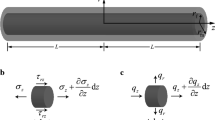Abstract
A three dimensional fibre-reinforce thermoelastic model is proposed here for an anisotropic medium with lagging behaviour in the presence of heat source and gravity. In the context of memory dependent derivative, the basic governing equations and heat conduction equation are adopted here. The analytical solutions are obtained by forming the vector–matrix differential equation in the transform domain. The graphical representation and numerical analysis of diffrerent physical variables with respect to different space variables have been done to verify the initial and boundary conditions.




Similar content being viewed by others
Abbreviations
- \(Q=Q(x,y,t)\) :
-
Heat source
- \(\rho \) :
-
Mass density
- \(T_{0}\) :
-
Reference uniform temperature of the body
- T:
-
Temperature change of a material particle
- \(e_{ij}\) :
-
Strain components
- \(\tau _{ij} \) :
-
Stress components
- \(u_{i}\) :
-
Displacement components
- e:
-
Dilatation
- P:
-
Initial stress
- \(C_{E} \) :
-
Specific heat constant
- \(\varepsilon ={\textstyle \frac{\gamma ^{2} T_{0} }{\rho C_{E} (\lambda +2\mu )}} \) :
-
Thermal coupling parameter
- \(\lambda ,\mu _{T}\) :
-
Elastic parameters
- \(\lambda ,\mu \) :
-
Lame’s constant
- \(\alpha ,\beta ,(\mu _{L} -\mu _{T} )\) :
-
Reinforced anisotropic elastic parameter
- \(\omega \) :
-
Rotational component
- \(\tau \) :
-
Relaxation time
- \(\tau _{q} \, ,\tau _{\theta } \) :
-
Dual-phase-lag
- \(q_x\) :
-
Feat flux
- \(\alpha _{T} \) :
-
Coefficient of linear thermal expansion
References
Abbas, I.A., Youssef, H.M.: Two-temperature generalized thermoelasticity under ramp-type heating by finite element method. Meccanica 48(2), 331–329 (2013)
Abbas, I.A.: A dual phase lag model on thermoelastic interaction in an infinite fiber-reinforced anisotropic medium with a circular hole. Mech. Based Des. Struct. Mach. 43(4), 501–513 (2015)
Abbas, I.A.: Eigenvalue approach for an unbounded medium with a spherical cavity based upon two-temperature generalized thermoelastic theory. J. Mech. Sci. Technol. 28(10), 4193–4198 (2014)
Abbas, I.A.: Three-phase lag model on thermoelastic interaction in an unbounded fiberreinforced anisotropic medium with a cylindrical cavity. J. Comput. Theor. Nanosci. 11(4), 987–992 (2014)
Belman, R., Kalaba, R.E., Lockett, J.: Numerical Inversion of the Laplace Transform. American Elsevier, New York (1966)
Biot, M.A.: Thermoelasticity and irreversible thermodynamics. J. Appl. Phys. 27(3), 240–253 (1956)
Caputo, M.: Linear models of dissipation whose Q is almost frequency independent II. Geophys. J. Int. 13(5), 529–539 (1956)
Chandrasekhariah, D.S.: Hyperbolic thermoelasticity: a review of recent literature. Appl. Mech. Rev. 21(12), 705–729 (1998)
Das, B., Lahiri, A.: A generalized thermoelastic problem of functionally graded spherical cavity. J. Therm. Stress 38, 1183–1198 (2015)
Das, B., Chakraborty, S., Lahiri, A.: Non-linear thermoelastic analysis of an anisotropic rectangular plate. J. Mech. Adv. Mater. Struct. https://doi.org/10.1080/15376494.2019.1578010(2019)
Dhaliwal, R.S., Sherief, H.H.: Generalized thermoelasticity for anisotropic media. Q. Appl. Math. 33(1), 1–8 (1980)
Diethelm, K.: Analysis of Fractional Differential Equations: An Application-Oriented Exposition Using Differential Operators of Caputo Type. Springer, Berlin (2010)
Ghosh, D., Lahiri, A., Kumar, R., Roy, S.: 3D thermoelastic interactions in an anisotropic elastic slab due to prescribed surface temperature. J. Solid Mech. 10(3), 502–521 (2018)
Ghosh, D., Lahiri, A.: A Study on the generalized thermoelastic problem for an anisotropic medium. J. Heat Transf. 140(9), 094501 (2018)
Green, A.E., Lindsay, K.A.: Thermoelasticity. J. Elast. 2(1), 1–7 (1972)
Green, E., Naghdi, P.M.: A re-examination of the basic postulates of thermomechanics. Proc. R. Soc. Lond. A 8, 12 (1991)
Hetnarski, R.B., Ignaczak, J.: Soliton-like waves in a low temperature nonlinear thermoelastic solid. Int. J. Eng. Sci. 34(15), 1767–1787 (1996)
Hetnarski, R.B., Ignaczak, J.: Generalized thermoelasticity. J. Therm. Stress. 22(4), 451–476 (1999)
Kosinski, W., Cimmelli, V.A.: Gradient generalization to inertial state variables and a theory of super fluidity. J. Theor. Appl. Mech. 35, 763–779 (1997)
Lahiri, A., Das, B.: Eigenvalue approach to generalized thermoelastic interactions in an unbounded body with circular cylindrical hole without energy dissipation. Int. J. Appl. Mech. Eng. 13(4), 939–953 (2008)
Lord, H.W., Shulman, Y.: A generalized dynamical theory of thermoelasticity. J. Mech. Phys. Solids 15(5), 299–309 (1967)
Othman, M.I.A., Abbas, I.A.: Effect of rotation on plane waves at the free surface of a fibre-reinforced thermoelastic half-space using the finite element method. Meccanica 46(2), 413–421 (2011)
Othman, M.I.A., Abbas, I.A.: Generalized thermoelasticity of thermal-shock problem in a non-homogeneous isotropic hollow cylinder with energy dissipation. Int. J. Thermophys. 33(5), 913–923 (2012)
Roy Choudhuri, S.K.: On a thermoelastic three-phase-lag model. J. Therm. Stress. 30(3), 231–238 (2007)
Sherief, H.H., Anwar, MdN: Problem in generalized thermoelasticity. J. Therm. Stress 9(2), 165–181 (1986)
Tzou, D.Y.: A unified field approach for heat conduction from macro- to micro-scales. J. Heat Transf. 117(1), 8–16 (1995)
Wang, J.L., Li, H.F.: Surpassing the fractional derivative: concept of the memory-dependent derivative. Comput. Math. Appl. 62, 1562–1567 (1995)
Zenkour, M.A., Abbas, I.A.: A generalized thermoelasticity problem of an annular cylinder with temperaturedependent density and material properties. Int. J. Mech. Sci. 84, 54–60 (2014)
Funding
This study was funded by RUSA 2.0 (Grant Number: R-11/476/19) (Jadabpur University).
Author information
Authors and Affiliations
Corresponding author
Ethics declarations
Conflict of interest
The authors declare that there is no potential conflict of interest regarding the authorship, research and publication of this article.
Additional information
Publisher's Note
Springer Nature remains neutral with regard to jurisdictional claims in published maps and institutional affiliations.
Appendix
Appendix
\(A_{11}=\lambda +2\alpha +4\mu _{L}-2\mu _{T}+\beta \), \(A_{12}=\lambda +\alpha \), \(A_{13}=\mu _{T} \), \(A_{14}=\alpha +2\mu _{T} \), \(A_{22}=\lambda +2\mu _{T} \)
\(R_{1j}=(\beta _{1}\lambda _{1}x_{1j}+\beta _{2}x_{2j}+\beta _{3}x_{3j}+\beta _{4}x_{4j})e^{\lambda _{j}x_{1}}\), \(R_{2j}=(\beta _{5}\lambda _{1}x_{1j}+\beta _{6}x_{2j}+\beta _{7}x_{3j}+\beta _{8}x_{4j})e^{\lambda _{j}x_{1}}\), \(R_{3j}=(\beta _{9}\lambda _{1}x_{1j}+\beta _{10}x_{2j}+\beta _{11}x_{3j}+\beta _{12}x_{4j})e^{\lambda _{j}x_{1}}\), \(R_{4j}=(\beta _{13} x_{2j}+\beta _{14}x_{3j})e^{\lambda _{j}x_{1}}\),
\(L_{1j}=\beta _{1}\lambda _{1}x_{1j}+\beta _{2}x_{2j}+\beta _{3}x_{3j}+\beta _{4}x_{4j}\), \(L_{5j}=\beta _{15} x_{1j}+\beta _{16}\lambda _{j} x_{3j}\), \(L_{6j}=\beta _{17} x_{1j}+\beta _{18}\lambda _{j} x_{2j}\), \(L_{8j}=x_{4j} \)
Rights and permissions
About this article
Cite this article
Ghosh, D., Lahiri, A. Three Dimensional Fibre-Reinforce Anisotropic Half Space with Lagging Behavior in the Presence of Heat Source and Gravity. Int. J. Appl. Comput. Math 6, 40 (2020). https://doi.org/10.1007/s40819-020-0783-z
Published:
DOI: https://doi.org/10.1007/s40819-020-0783-z




